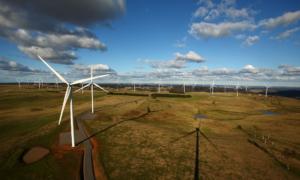Electricity grid capacity available in the world isn’t keeping pace with the rapid growth of “clean energy” technologies, possibly putting governments’ climate goals at risk, according to a recent report by the International Energy Agency (IEA).
“At least 3,000 gigawatts (GW) of renewable power projects, of which 1,500 GW are in advanced stages, are waiting in grid connection queues—equivalent to five times the amount of solar PV and wind capacity added in 2022,” the report noted.
“This shows grids are becoming a bottleneck for transitions to net zero emissions.”
While investments in renewable energy such as solar and wind power, electric vehicles (EV), and heat pumps have been “increasing rapidly”—almost doubling since 2010—the investment in power grids has remained “static” at around $300 billion annually, it said.
The 2015 Paris Climate Accords agreed to hold the global increase in average temperature to 1.5 degrees Celsius above pre-industrial levels. Delays in establishing the necessary power grid could put this target “out of reach,” the report stated.
IEA presented a “Grid Delay Case” scenario in which the modernization of existing power grids and the setting up of new grids don’t happen in a timely manner. In such a situation, there would be 58 gigatonnes of additional CO2 emissions from the power sector, as compared to a situation in which the national climate targets are achieved.
“This is equivalent to the total global power sector CO2 emissions from the past four years. It would also mean that the global long-term temperature rise would go well above 1.5 degrees Celsius, with a 40 percent chance of it exceeding 2 degrees Celsius,” it said.
While the IEA report proposes boosting the power grid infrastructure to accomplish the transition to green energy, such transitioning attempts could endanger the reliability of the grid.
In an Aug. 8 statement, a group of Independent Systems Operators and Regional Transmission Organizations warned the U.S. Environmental Protection Agency (EPA) that the agency’s proposed emission regulations on the power sector “have the potential to materially and adversely impact electric reliability.”
A host of CO2 emissions rules and decades of efforts to limit fossil fuels have resulted in the retirement of coal and gas power plants at a pace faster than the installation of solar and wind facilities, it said.
US Power Grid Problem
In an interview with EpochTV earlier this month, energy-related public policy analyst David Blackmon called the power grid issue in the United States a “huge problem.”“And it’s much bigger than people know because right now, we have a crisis in [the] supply of electric transformers for our power grid,” he said. “Transformers are an integral part of every electricity project in America—around the world, really—and they’re in very short supply. It’s taking up to four years to source new supplies of these transformers. Inventories are very low.
“And, you know, you can’t expand the grid if you don’t have the equipment to do it with. The federal government is not doing anything to solve this problem.”
In March, IEEE Spectrum, a publication of the Institute of Electrical and Electronics Engineers, published a report on EV transition that highlighted several of the cost challenges in preparing the grid for an electric economy.
Costs of transformers have jumped to as much as $20,000 each, from $3,000 to $4,000, the report said. As larger transformers may be required to support EVs, many of the 180 million power poles in America would also have to be replaced, pushing up the cost further.
Improvements and replacements to the grid’s 8,000 power-generation units and 600,000 circuit miles of AC transmission lines, as well as 70,000 substations to support increased renewable energy and battery storage, are estimated to cost more than $2.5 trillion by 2035, according to the report.
In contrast, renewable energy projects can be completed in just one to five years. It also pointed out that grid investments would need to double by 2030 from current levels to more than $600 billion per year.
Moreover, while the IEA report presents renewable energy as a pro-climate action, such energy projects can pose serious pollution risks.
Toxic chemicals in solar panels include cadmium telluride, lead, hexafluoroethane, and more. In addition, silicon tetrachloride, a chemical created as a byproduct of solar panel manufacturing, can cause severe irritation and burns to the skin and eyes.
Tossing solar panel waste in landfills presents a long-term risk to the environment as the toxic minerals and metals can end up seeping into the ground.







